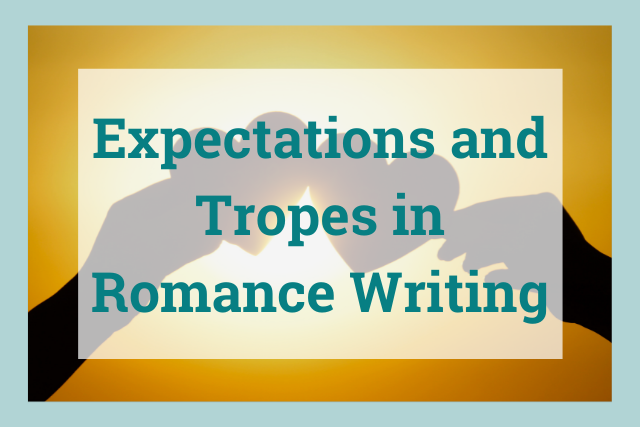
It’s a tale as old as time. People love reading and writing about romance.
From ancient epic poems to saucy eBooks, the romance genre has changed and evolved without ever losing popularity. But what do all these stories have in common?
Well, for one thing, they have love. That’s the first crucial ingredient.
Romance is one genre than can easily fall into tired tropes. Devoted romance fans may have tropes that they love to read over and over, but we also crave fresh takes on these plots.
On the other hand, romance readers have expectations. There are some things that are generally accepted as necessary for this genre.
Meeting these expectations while trying to freshen up tropes can have authors walking a tightrope. It’s a balancing act, and with this article, we’re here to help.
Romance Genre Expectations
Everyone has different tastes when it comes to romance. Some people want light-hearted fun, while others crave a dark romance. Some people want taboo themes while others want a romantic comedy.
But there’s one thing that almost everyone agrees on: romance needs a Happily Ever After.
Happily Ever After, commonly abbreviated as HEA, doesn’t just mean marriage and babies. That’s not everyone’s idea of happiness, after all.
Traditionally, romance novels would feature a damsel in distress who pines for a Prince Charming. Hello? The 21st century called and who needs saving anyways?
Which then brings us to Happily For Now (HFN). This means we leave the characters in a good place without necessarily knowing what the future holds for them. Readers get just enough dopamine knowing that their favorite characters will be ok.
The Romance Writers of America state that it’s not a romance if the love story doesn’t have “an emotionally satisfying and optimistic ending.”
In her article on Book Riot, Sarah Nicolas goes so far as to say that if romance doesn’t have a happy ending, then there’s no point in having genre labels. “A genre label exists to give the reader an idea of what to expect,” she writes.
The key here is not that your book can’t be sad. Nicholas Sparks has built an empire on tear-jerking, emotionally poignant novels. But the love stories themselves are satisfying. Love wins in these books, even if the characters die.
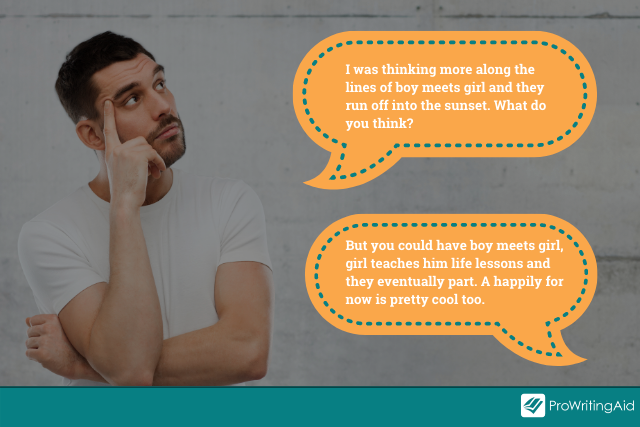
Here are some questions to consider if you want to write a non-traditional HEA.
- If one love interest dies, was the relationship in a good place?
- Did the love story change the living character(s) for the better?
- If the characters are not together or one dies at the end, do the remaining characters have a chance at another HEA?
- Is the ending emotionally satisfying?
Think about Nicholas Sparks’ A Walk To Remember. Though Jamie dies from cancer, Landon is changed forever because of her love.
He is no longer a thug without empathy. He has found meaning and purpose, and it’s understood that he will have a long, happy life because of their relationship.
The movie La La Land is another example of a romance with a non-traditional HEA. The love story helped the main characters grow, but they needed to find independence. They both have happy lives with other people at the end.
Their love story was a crucial part of their growth as young adults, but they weren’t soulmates.
There is an infinite number of ways to mix up the HEA/HFN expectation, but it should still be there or your readers will feel ripped off. As Pinar Tarhan, one of my favorite indie romance authors, told me, “if I want to lose faith in humanity, I’ll watch the news.”
She reads and writes romance for hope and emotional satisfaction.
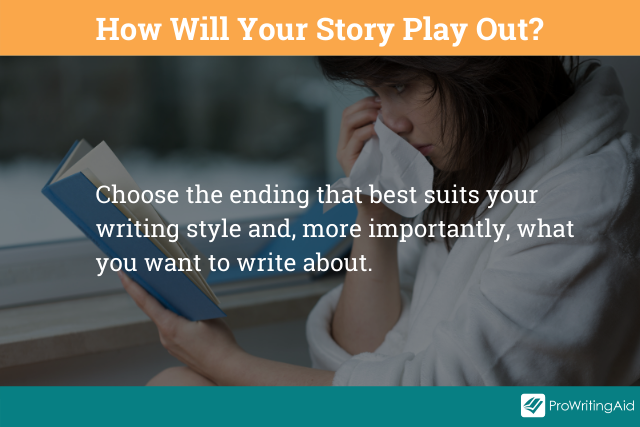
The best way to learn what your readers are expecting is to read romance. Start with our list of the best romance books of all time to learn timeless techniques and new trends.
Coming Up With a Romance Structure
In addition to a Happily Ever After, there are a few key plot points that are expected and keep the story moving. You don’t want the characters to get their Happily Ever After too soon, but you don’t want to torture your readers with endless obstacles either.
Romance structure isn’t a hard and fast rule. It’s not really even a formula, although I’ve seen many people disagree. There are loose guidelines that make a love story make sense.
Everyone has their own structure when they write a romance. I have seen everything from nine plot points to more than 20 “requisite” scenes. There’s even a theory that a romance needs “three dates” to be well structured.
While your structure can be unique to your writing preference, as a romance novelist, there are still some pretty common mistakes that first-time writers make.
Be sure to check out this article on how to avoid 13 mistakes that first-time romance writers make so you can be ahead of the curve.
ProWritingAid also has an extensive Writer's Resources Library to help you with your own romance story.
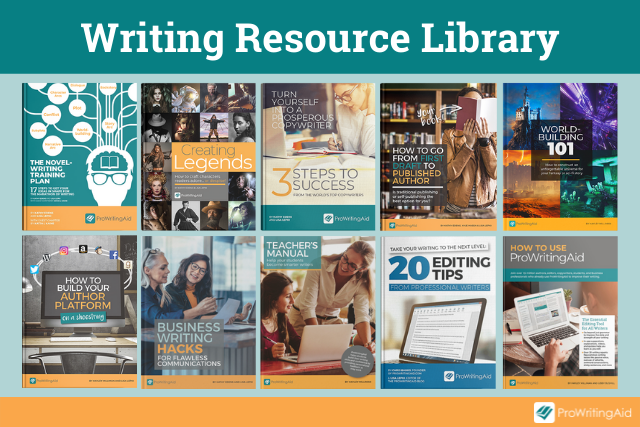
There are seemingly a lot of rules for this art form. I prefer to think of romance structure as having five key elements that can have any number of scenes and any variety of storylines:
- Meet cute
- Romantic tension
- Getting together/almost getting together
- Torn apart
- HEA/HFN
(Need more inspiration? Check out this list of 81 romance prompts to start your writing journey.)
1. Meet Cute
The love interests have to meet somehow. If they already know each other when the story begins, then introduce readers to how they first met, perhaps through conversation.
Readers love a good origin story. If they are friends or enemies when the story starts, show where the relationship dynamic begins to change.
2. Romantic Tension
This is what readers live for. Give them those tiny moments that show increasing romantic tension. These are the breadcrumbs for the final goal of the story.
3. Getting Together/Almost Getting Together
In some romances, the characters get together for a while, then break up. There could be a fight or a move across the country. Sometimes it’s the characters’ own insecurities. They can also almost get together, but not quite.
4. Torn Apart
Misunderstandings, problematic exes, kidnapping—these are all ways to keep your characters from getting their happy ending too soon. Get creative!
5. HEA/HFN
Show us that happy ending! Even if you’re just implying that things will be good for these characters, that’s enough.
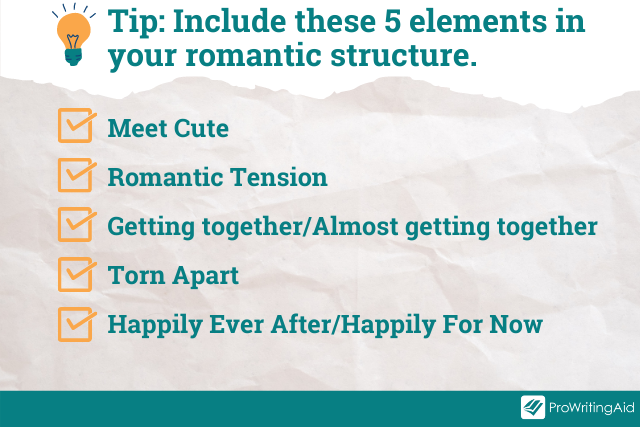
Tropes and How to Break Them
We all have our favorite romance tropes. I am a sucker for the “friends to lovers” trope. I also love a good “fake relationship” story.
But the problem with tropes is that they're overdone. Don't get me wrong, there’s nothing wrong with them inherently; someone out there will definitely love it.
But as writers, we want to strive for original ideas. I asked a couple of my indie author friends how they turn romance tropes on their heads.
Pinar Tarhan offered some great advice: “When you are writing romance, think of everything you hated in every romantic plot or subplot you’ve read and watched. Avoid these. Reverse situations. Reverse gender.”
Rosie Chase writes characters that are outside the norm. She wrote a billionaire romance where the characters ended up “no longer rich.”
What does this look like in practice? Let’s take a look at a few tropes and some ideas for how to freshen them up.
The Rake
In romance, the “rake” is usually the man. He’s often a playboy who is afraid of commitment. He may or may not be involved in some bad-boy activity. He needs to be tamed.
What’s stopping you from making the rake the woman? I had the privilege of beta reading Nicollette Norwood's new book, The New Teacher.
The main character is a woman who hates relationships. She has new hook-ups all the time, and she is terrified of commitment. The man she falls in love with is the exact opposite.
He’s emotionally available and has only ever been in serious relationships. It was refreshing and empowering to read. Take this as confirmation and have the courage to go against the grain in your own writings.
Forced Proximity
Stuck in an elevator. Snowed in in a cabin. Oh, no! There’s only one bed! Usually, these two characters can’t stand each other, but their forced proximity makes them fall in love. I have to admit, I love this trope.
What if they were friends first and the forced proximity makes them hate each other? They don’t fall in love until after they are out of the situation. How can you make this situation as un-romantic as possible?
Celebrity or Common Person?
Who hasn’t dreamed of falling in love with someone glamorous to take us out of our stressful, mundane lives?
But millionaires, celebrities, or royals as love interests can quickly become cliché. Sure, readers might want to escape from the monotony of their daily routine but it doesn't hurt to make the content relatable.
“Fan-celebrity romances might not feel fresh,” Pinar told me. “But what if the celebrity chases a hater?”
Or take inspiration from real life. Prince Harry and Meghan Markle just stepped back from their royal duties for the sake of their marriage. Does your princess give up being a royal for her new love interest?
Creating Fresh Characters
You can subvert plot tropes all day, but the key to freshening up these tropes is in your characters.
Romance gets a lot of flack for having the same characters over and over: the Mary Sue who doesn’t know she’s beautiful and the Greek god incarnate, emotionally unavailable man.
The world is a lot more diverse than that, and these characters are hard for most readers to relate to.
Consider giving your characters different types of bodies. Write characters who aren’t neurotypical. Give your characters plenty of flaws, but not the flaws people would expect.
There is more than one type of romantic relationship, too. Polyamory, queer love stories, asexual romance—these are the reality for millions of people. Write the story you want to write (and not the one you're expected to) because your audience is out there.
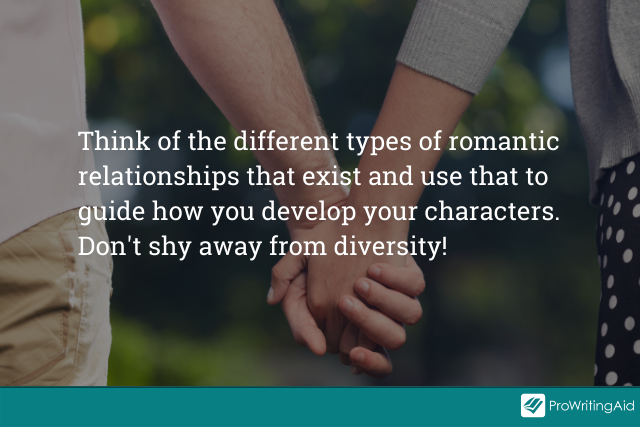
Balancing Expectations While Breaking Tropes
I asked Rosie Chase how she balances the expectations of romance while also trying to freshen up tired tropes. “It is a constant worry. This is my job, and I want to succeed,” she said. “But really it doesn’t matter. I write what I write.”
“I think the best thing about romance is that we have the basics down. You need two people to meet, to fall for each other, have some obstacles and conflicts along the way,” Pinar says. But this isn’t a formula, she reminded me.
At least two characters need to meet, fall in love, and have some sort of happy ending. The rest is up to you. No two love stories are exactly the same, but every love story leaves the world a little more beautiful.
Writing Your Own Romance
Writing a romance is a balancing act of sorts and managing what's expected and your own unique style can be a daunting task. While it can be overwhelming, there is no reason to despair. Having a supportive community is important to any writer, regardless of genre.
At ProWritingAid we believe that writing is better together, and that can look like community webinars with industry experts or live writing training sessions.


